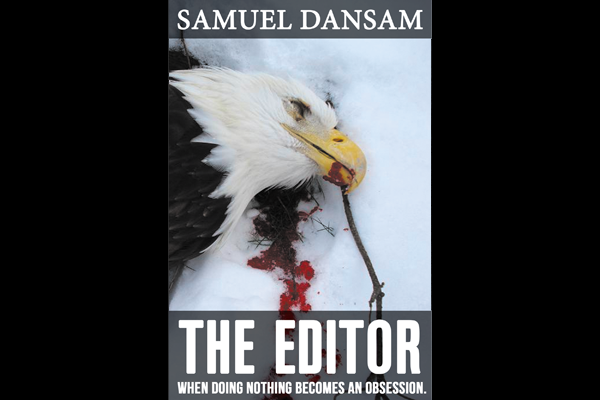The Editor
By Samuel Dansam
Samuel Dansam’s The Editor reads like an unpreventable car accident. The story at the beginning is too good to last, the characters too happy not to fail, the setting too beautiful not to house something awful. Underneath the veneer of a perfectly boring town, full of perfectly similar family homes, occupied by horrifically perfect families, is a newspaper under the helm of a new editor-in-chief, the delusional, depressed, and despicable David Stein.
Dave needs a fresh start. He packs up his old Dodge, writes his wife and kids a letter that leaving for a short time is the only thing that will make him better, then pays his local tavern one last visit before hitting the road. Dave’s a maintenance alcoholic, a borderline hypochondriac, and a bitter bull-shitter with an incredible eye for finding what he dislikes in just about everything: he is undeniably a fantastic editor.
He arrived in Brighton, “that fucking nondescript, know-nothing of a name,” hung-over, with a piece of vomit caught in his throat. He checks into his hotel, raids the minibar, and offends the concierge before stumbling out of the lobby onto Main Street amongst the faces of Brighton – the “pretty little balloons of dumb eyes, dough-cheeks, and fudge-noses, fake down to their sheen and creasing.” The next morning, after a slew of poor decisions, Dave walks into the newspaper on the blank page of a blackout.
Here, Dansam shifts the narrative from following Dave to containing him. The middle of the novel is predominantly staged in the newsroom where Dave practically lives, but does very little. He depends on his news editor, online editor, and Nancy, the hilariously vulgar columnist and sub-editor, to point him in the right direction to get the paper out on time. Dave takes it upon himself not merely to edit the works of his “hopeless and pandering” writing staff, but to re-write their work without their knowing until it arrives in print. Humorously, the whole culture of the newspaper takes a dive due to Dave’s vision. The writers adapt their style to appease Dave’s concept of a brutally honest and edgy paper bent on exposing the “dark truths” behind the happy façade of Brighton’s establishment. With a hapless publisher never present in the wheel room, Dave’s vision goes unchecked, but the outcome leads to an exodus in the advertising department and the resignation of the news editor.
Growing increasingly disturbed, Dave draws and quarters the Arts Section. The food page is turned into a culinary killing spree when Dave fires the section’s 80-year-old writer of “Cooking with Claire,” and replaces her with Debbie Shoemaker, a 16-year-old bulimic cheerleader from Brighton High. The section’s new title, “Put it in Your Box: Easy microwave recipes,” brings the town to mass hysteria and leads to several local restaurants threatening suit as the section’s angle is predominantly based on reheating the leftovers from local eateries. Seemingly, the only sane person of the lot is the books editor, Diego Intrepid, due to his ability to disappear into thin air whenever he is needed.
Dansam brilliantly weaves this mass of comedic excess and madness into a revenge plot based on Dave’s affair with Nancy. When the newspaper’s absentee publisher unexpectedly dies in the Bahamas and is replaced with his widow, whom Dave subsequently becomes obsessively in love with because she looks exactly like his late wife, the reader becomes privy to two very important facts: first, that Dave’s wife and children actually died in an unfortunate sledding accident two years before, and that Nancy the hilariously raunchy (but edgy) columnist and sub-editor would do anything to win back Dave’s tiny, dingy, artificial watermelon-flavoured heart.
The novel’s absurdity teeters on the edge between humorous and harrowing. Yet, when the climax draws near, the darker and more troubling it becomes. The Editor’s final twist and masterful conclusion is delightfully offensive, sexy and gory –containing exactly all the things Dave wanted to integrate into the Brighton Herald.



